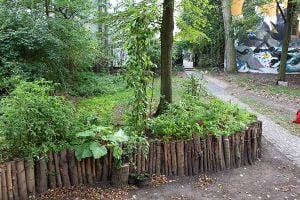Raised bed gardens

Raised bed gardening is an excellent technique for growing plants while minimizing physical strain, making it ideal for gardeners of all abilities.
The use of a permanent raised beds is a great way to reduce work when you start your season. It reduces erosion and allows better drainage, and enables people to participate in gardening who are not physically able to work a ground-level bed. It's usually used in combination with mulch. The raised bed can have a framework or not, depending on the needs.
- Framed raised beds: These are the most common type of raised beds, featuring a physical frame made from materials like wood, stone, or metal. While framed beds provide structure and stability, they also require more effort and cost to construct. Frames are typically used to prevent soil from spilling over and provide a neat, organized appearance. However, they can harbor perennial weeds and pests, making maintenance more difficult.
- Unframed Raised Beds: These beds don’t have a framework and are simply raised above the ground using a mound of soil. While they provide more flexibility and space for planting, they are more prone to erosion unless plants are installed along the sides with mulch. Unframed beds are an affordable, low-maintenance option that can be easily expanded or adjusted.
- Keyhole gardens are a circular version of a framed raised bed. The charity 'Send a Cow' is promoting the creation of these in Africa. Keyhole gardens are highly productive and water-efficient, making them ideal for regions with limited water resources.
What Are Raised Bed Gardens?[edit | edit source]
A raised bed garden is essentially an elevated planting space, typically constructed using a framework or without one, depending on the gardener’s needs. These beds are filled with nutrient-rich soil and are usually mulched to maintain moisture and improve soil health. Raised beds can be used for growing vegetables, herbs, and flowers and are suitable for a wide range of gardening spaces, from small urban areas to expansive country plots.
Benefits of Raised Bed Gardens[edit | edit source]
- Raised beds significantly reduce the effort required to maintain your garden. They minimize erosion by elevating the soil, allowing for better water retention and reducing the risk of soil washing away.
- They're particularly beneficial for individuals who have difficulty bending down or kneeling. The elevated structure makes gardening more accessible to people with physical limitations, allowing them to enjoy gardening without straining their back or knees.
- One of the major advantages of raised bed gardens is improved drainage. Raised beds allow excess water to flow away easily, preventing waterlogged roots and encouraging healthier plant growth. They also enable gardeners to customize soil mixtures, ensuring that each plant type receives the best possible environment.
- Without the constraints of ground-level soil, raised beds allow for better cultivation space. They can be planted with more crops, and mulch can be used to maintain soil health and reduce weed growth.
How to Build a Raised Bed Garden[edit | edit source]
Building a raised bed garden involves a few simple steps:
- Select a sunny spot that receives at least 6 hours of sunlight daily. Raised beds can be placed on any surface, but good drainage is key.
- For framed beds, materials like untreated wood, brick, or stone are commonly used. Make sure the materials are free of harmful chemicals.
- Fill the raised bed with a mixture of topsoil, compost, and organic matter. You can also add mulch to retain moisture and control weeds.
- Once the bed is filled, plant your crops and ensure regular watering and maintenance. Mulch will help prevent weed growth and keep the soil moist.
See also[edit | edit source]
External links[edit | edit source]
- Wikipedia:Raised bed gardening
- Raised-Bed Gardening - University of Missouri Extension.
- Keyhole Garden - Send a Cow
- Video showing how to make a Keyhole Garden - Youtube content